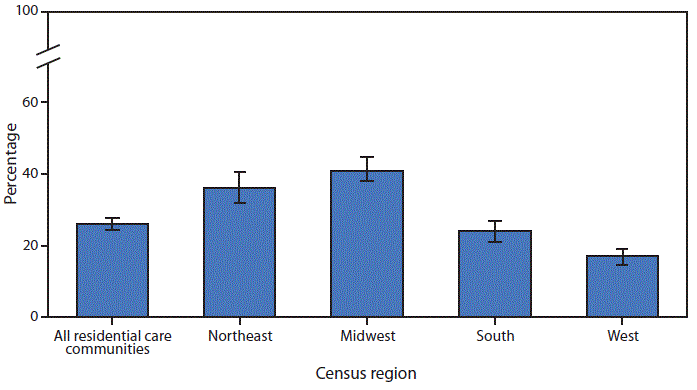QuickStats: Percentage* of Residential Care Communities† That Use Electronic Health Records,§ by Census Region¶ — United States, 2016
Weekly / June 29, 2018 / 67(25);730
Altmetric:

* With 95% confidence intervals indicated with error bars.
† Residential care communities include those that were state-regulated; had four or more beds; and provided room and board with at least two meals a day, around-the-clock on-site supervision, and help with personal care, such as bathing and dressing or health-related services such as medication management. Residential care communities licensed exclusively to serve the mentally ill or the intellectually or developmentally disabled populations were excluded; residential care communities with missing data were excluded.
§ Respondents were asked “An Electronic Health Record is a computerized version of the resident’s health and personal information used in the management of the resident’s health care. Other than for accounting or billing purposes, does this residential care community use electronic health records?”
¶The United States Census Bureau defines four regions comprising the following states: Northeast: Connecticut, Maine, Massachusetts, New Hampshire, New Jersey, New York, Pennsylvania, Rhode Island, and Vermont; Midwest: Illinois, Indiana, Iowa, Kansas, Michigan, Minnesota, Missouri, Nebraska, North Dakota, Ohio, South Dakota, and Wisconsin; South: Alabama, Arkansas, Delaware, District of Columbia, Florida, Georgia, Kentucky, Louisiana, Maryland, Mississippi, North Carolina, Oklahoma, South Carolina, Tennessee, Texas, Virginia, and West Virginia; West: Alaska, Arizona, California, Colorado, Hawaii, Idaho, Montana, Nevada, New Mexico, Oregon, Utah, Washington, and Wyoming.
In 2016, 26% of residential care communities used electronic health records (EHRs). The percentage that used EHRs was 36% of communities in the Northeast, 41% of communities in the Midwest, 24% of communities in the South, and 17% of communities in the West.
Alternate Text: In 2016, 26% of residential care communities used electronic health records (EHRs). The percent that used EHRs was 36% of communities in the Northeast, 41% of communities in the Midwest, 24% of communities in the South, and 17% of communities in the West.
Source: National Study of Long-Term Care Providers, 2016 data. https://www.cdc.gov/nchs/nsltcp/index.htm.
Reported by: Christine Caffrey, PhD, ccaffrey@cdc.gov, 301-458-4137; Vincent Rome, MPH.
Suggested citation for this article: QuickStats: Percentage of Residential Care Communities That Use Electronic Health Records, by Census Region — United States, 2016. MMWR Morb Mortal Wkly Rep 2018;67:730. DOI: http://dx.doi.org/10.15585/mmwr.mm6725a8.
MMWR and Morbidity and Mortality Weekly Report are service marks of the U.S. Department of Health and Human Services.
Use of trade names and commercial sources is for identification only and does not imply endorsement by the U.S. Department of
Health and Human Services.
References to non-CDC sites on the Internet are
provided as a service to MMWR readers and do not constitute or imply
endorsement of these organizations or their programs by CDC or the U.S.
Department of Health and Human Services. CDC is not responsible for the content
of pages found at these sites. URL addresses listed in MMWR were current as of
the date of publication.
All HTML versions of MMWR articles are generated from final proofs through an automated process. This conversion might result in character translation or format errors in the HTML version. Users are referred to the electronic PDF version (https://www.cdc.gov/mmwr) and/or the original MMWR paper copy for printable versions of official text, figures, and tables.
Questions or messages regarding errors in formatting should be addressed to mmwrq@cdc.gov.